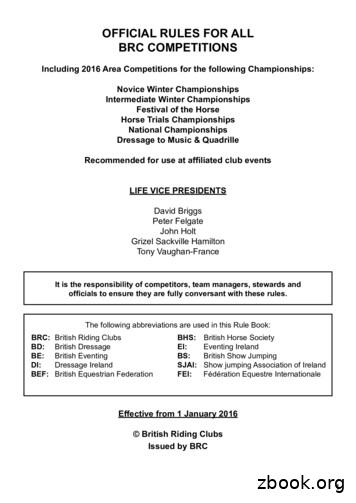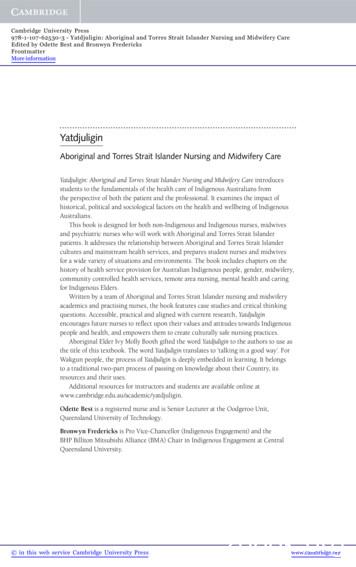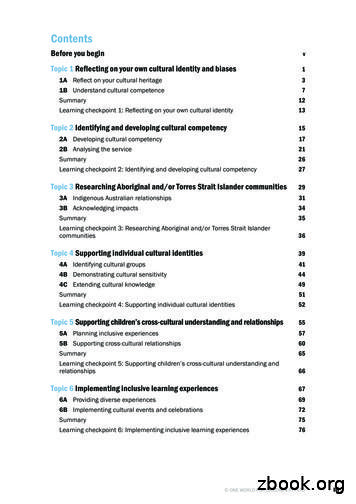British Vs American Cultural Elements In EFL Textbooks
Sveučilište u ZagrebuFilozofski fakultetOdsjek za anglistikuKatedra za metodikuBritish vs American cultural elements in EFL textbooksDiplomski radStudent: NatašaUdovičićMentor: dr. sc. Renata Geld, docentZagreb, 2018
University of ZagrebFaculty of Humanities and Social SciencesDepartment of EnglishTEFL SectionBritish vs American cultural elements in EFL textbooksGraduation ThesisStudent: NatašaUdovičićSupervisor: Asst. Prof. Renata Geld, Ph. D.Zagreb, 2018
Examining Committee:Stela Letica Krevelj, Ph.D., postdoc.Jasenka Čengić, M.Ed., Teaching and Research AssistantAssistant Professor Renata Geld, Ph.D.
Sadržaj1. Introduction . 12.1. Culture inthe classroom . 33. Textbooks . 44. The Croatian National Educational Standard (CNES) . 45. Previous studies . 46. Research . 56.1. Aim . 56.2. Sample . 76.3. Procedure . 87. Results . 87.1. British cultural elements . 87.2. American cultural elements . 157.3. Results of Big “C’’ culture and small “c’’ culture . 207.3.1. The analysis of Solutions . 207.3.2. The analysis of Success . 23
7.3.3. The analysis of Message 2 . 257.3.4. The analysis of The New Headway. 287.4. Discussion. 308. Conclusion . 319. References . 32
AbstractIn every EFL classroom, cultural elements of a target language should be incorporatedinto the syllabus. In that way, students are encouraged to develop certain aspects ofintercultural competence. In Croatia, the Croatian National Educational Standard places anemphasis on cultural elements. This paper investigates the types and numbers of culturalelements which can be found in textbooks used in Croatia, as well as try to determine whichculture predominates. Cultural elements from textbooks were grouped under Big “C’’ culturesand small “c’’ cultures, and nine categories proposed by Byram to be of minimal culturalcontent. The results showed that British culture predominates, as well as topics referring toBig “C’’ culture.Keywords: culture, textbooks, textbook analysis, Big “C’’ culture, small “c’’ culture, Byram
1. IntroductionThe main goal of the study described in this paper was to examine elements of British andAmerican cultures found in four textbooks. In the past, culture was neglected in EFL classrooms.Students practised vocabulary, grammar, and the four language skills. However, over time culturehas become more and more present in EFL teaching materials. Each society has its own culture, andwhen people come in contact with other societies, they often experience a cultural shock. Therecommendation for overcoming cultural differences is development of intercultural competence.The first section of this paper provides a definition of culture, and discusses the importance ofculture in EFL classrooms. The second section is a brief summary of textbooks examined, and theCroatian National Educational Standard. The third section provides an overview of previous studiesconducted in this field. It includes description of three relevant studies- by Lappalainen, by Brdarićand by TuĎa. Finally, the fourth section examines four textbooks based on the Big “C’’ culture andsmall “c’’ culture, and research which supports Byram’s content of cultural learning.2. CultureRobinson suggests that there are four different types of culture that are defined from thefollowing perspectives: behavioral, functional, cognitive and symbolic. A behaviourist definitiondescribes culture as numerous forms of behaviour. Those forms include habits, rituals and customsthat are typical for one group of people and some specific situations. From the functional point ofview, culture includes specific forms of behaviour and their relevance and importance for the society.From the cognitive viewpoint, culture does not include physical aspects. It focuses on theinterpretation of incoming data and experiences. Lastly, from the symbolic viewpoint culture is adynamic process that consists of different symbols and emphasises continuous change (Robinson1985, as cited in Heidari 2014).According to Brown (2007), society cannot exist without culture. Numerous factors such asideas, customs, arts and skills comprise culture. These cultural characteristics are shared by a groupof people that live together. These people tend to see reality through their culture, and they do notchange their perspective when they come into contact with another culture. For this reason, peoplefrom different cultures can disagree on many things. In addition, people judge members of anotherculture because they see them through the values and beliefs existing in their own culture. Damenstates that culture has six different characteristics. Culture is viewed as a universal fact and without itsociety cannot exist. It is something that is learnt and cultural patterns can change over time.However, culture contains certain values and beliefs that are unique. Damen stresses that culture and1
language are connected, exerting an influence on one another. Culture can be seen as a barrier thatprotects a society (Damen, 1987 as citied in Wages, 2015).Byram (1994, pp. 51-52) suggests nine different categories that can serve as the minimumcontent for cultural learning.1. Social identity and social groups- social identity is different from national identity. Itincludes social class, regional identity, ethnic minority and professional identity.2. Social interaction- It consists of conventions of verbal and non-verbal behaviour withinsocial groups.3. Belief and behaviour- Firstly, it includes habits and taken-for-granted actions of one socialgroup together with their moral and religious beliefs; secondly, it deals with daily routine.4. Socio-political institutions- institutions of the state that create a foundation for ordinary lifeand routine within the national and sub-national groups.5. Socialization and the life-cycle- institutions serve as a place for socialization-families,schools, employment, religion and military service.6. National history- historical and contemporary events that are crucial to understanding onenation and its identity.7. National geography- includes geographical factors that are important for interculturalcommunication.8. National cultural heritage- historical and modern cultural artefacts which are recognized byother members of the nation (e.g., Shakespeare in Britain, Wagner in Germany).9. Stereotypes and national identity- includes the typical image of a target culture andsymbols of national identity as well as stereotypes connected to the same (e.g. famous monumentsand people).Adaskou, Britten and Fahsi (1990) suggest that culture can be defined in the following ways:the aesthetic, the sociological, the semantic and the pragmatic (or sociolinguistic). They alsoenumerate possible reasons why cultural content should be included in a foreign language course. Infact, they conclude that cultural content helps in eliminating international disparities as students willlearn how to understand both their own culture and a foreign culture. Also, it helps them during theirtravels abroad. Our research, as we will describe later, will rely on the first two concepts. Accordingto Adaskou et al. (1990), the aesthetic sense covers topics such as the media, cinema, music(classical and popular) and literature. This concept is known as Culture with a capital C. Thesociological sense, which is proportional to culture with a small letter “c’’, includes materialconditions, customs, institutions, the organization and nature of family, interpersonal relations andwork and leisure.2
Chen (2004 as citied in Liu & Laohawiriyanon, 2014, p. 4) classifies seven themes fordescribing Big “C’’ and nine themes connected to small “c’’ cultures. In addition, Big “C’’ includeseconomy, education, geography, history, music,politics and social norms. Chen’s topics for small ‘c’are customs, daily routines, food, gesture, greeting, holiday, lifestyle, values and weather.2.1. Culture inthe classroomEFL literature stresses that skills which should be taught are writing, reading, listening andspeaking. However, it also notes that in addition to all of these skills, teachers should also teachabout culture. Unfortunately, in the past, culture and language were addressed separately in languageclassrooms around the world as culture was not seen as an aspect of language. For this reason,Kramsch states that cultural awareness must be seen as the foundation of language teaching, wherelanguage proficiency would not be possible without cultural awareness (Kramsch, 1993). Indiscussing the importance of culture, Kramsch’s cites Halliday who concludes that culture is presentin the grammar we use and the vocabulary we choose (Halliday, 1990 as cited in Kramsch, 1993). Intraditional teaching, culture was taught with the objective of conveying information about the peopleof the target country, and their general attitudes, neglecting the fact that culture was actually a socialconstruct (Kramsch, 1993).In the last few years, new ways of looking at the teaching of language and culture haveemerged. The role of language is seen in a new light, reflected in the following notions (Kramsch,1998, pp. 205-206):1. Establishing a “sphere of interculturality’’- in order to understand a foreign culture, alearner must step into the shoes of a foreigner. It is crucial to reflect both on the target culture and onthe native culture.2. Teaching culture as an interpersonal process- teacher should avoid teaching fixed languagestructures because learning must involve social interaction.3. Teaching culture as differences -teachers should try to avoid teaching culture by presentingnational traits such as the French do this, the Germans do that. Although not entirely wrong, theyshould be guided by other cultural factors such as age, gender, regional origin, ethnic backgroundand social class.4. Crossing disciplinary boundaries- teachers should include some other disciplines such asanthropology, sociology and semiology. In addition, besides literature, they can also use studies bysocial scientists, ethnographers and sociolinguistics who live in a foreign country.3
3. TextbooksAccording to Tomlinson (2012, p. 143), ‘’materials for language learning’’ (textbooks,videos, graded readers, flash cards, games, websites and mobile phone interactions) serve fivefunctions: informative, instructional, experiential, eliciting and exploratory.Textbooks have been used as basic classroom materials since the 19th century. The purposeof a textbook is to introduce students to a sufficient quantity of cultural materials, as well as enablethem to develop fundamental language skills that are crucial preconditions for students to learn howto communicate with people from different cultures (Radić-Bojanić and Topalov, 2016). Accordingto Sheldon, it is better to use textbooks than “home-produced photocopied teachers’ resources’’(Sheldon 1988, as citied in Radić-Bojanić and Topalov, 2016 pp.139-140). However, teachers mustbe aware of the fact that textbooks are not appropriate for every situation. Occasionally, it will berequired of teachers to adapt a textbook so it will fit a specific situation as it is impossible to find theperfect textbook (Cunningsworth, 1984 as citied in Radić-Bojanić and Topalov, 2006). Teachersshould be able to identify the strengths and weaknesses of textbooks because they help students inachieving their learning goals (Radić-Bojanić and Topalov, 2016).4. The Croatian National Educational Standard (CNES)CNES contains educational standards for teaching the English language, as the first foreignlanguage and as the second foreign language in elementary schools. These standards describe theknowledge students should acquire and relies on the Common European Reference Framework forLanguages (CEFR). The authors of CNES relied on six levels of communication defined by theCEFR, for grading students’ language proficiency. These are A1 (beginner), A2 (ElementaryEnglish), B1 (Intermediate English), B2 (Upper-Intermediate English), C1 (Advanced English) andC2 (Proficiency English) (4). However, students in Croatian primary school attain the A2 level aftereight years of learning. Intercultural competence has also been included in the syllabus, from thevery beginning. CNES provides educators with standards that promote systematic culturalknowledge (HNOS, 2006).5. Previous studiesLappalainen (2011), in her master’s thesis, investigated how cultural themes, in Finnish EFLtextbooks for secondary and upper secondary education, dealt with the principles of interculturallearning. At the same time, Lappalainen showed how cultural content related to the United Stateswas presented in older and more recent Finnish EFL textbooks. The study was based on theprinciples of intercultural learning and teaching proposed by Byram and Risager. Although she used4
22 books, only 6 books were included in the further analysis because only they included Americanculture. This study clearly showed that older textbooks had more American-related cultural topicsthan newer textbooks. Also, textbooks for secondary education better incorporated American culturethan textbooks for upper secondary education.In the next study conducted by Brdarić (2016), the cultural content in textbooks was analysedin order to investigate the connection between cultural content and the Croatian NationalCurriculum. Furthermore, the author designed a questionnaire with the aim of examining the viewsof English teachers on intercultural communicative competence (ICC). This study also addressed theissue of which culture, British or American, was more dominant in textbooks. The data indicates thatboth cultures, British and American, were equally represented in the textbooks used, with Croatianculture also included, primarily, in the section entitled “Comparing Cultures’’. The textbooksincluded authentic texts as excerpts from books and poems. In order to ascertain which culturedimension was most present, Brdarić analysed cultural elements according to four dimensions: theaesthetic sense, the sociological sense, the semantic sense and the pragmatic sense. The resultsshowed that the aesthetic and sociological dimensions were more dominant than the other twodimensions. The author suggests that the most likely explanation for this are topics which addressfamous people, literature and society. With respect to the questionnaire, it showed that teachers wereaware of the fact that culture is important in EFL teaching. They also realised that they shouldchange cultural outcomes because the given outcomes are repetitive and vague.TuĎa (2017) in her thesis studied the representation of culture in English textbooks, writtenboth by Croatian and British authors. The purpose of her study was three-fold: (a) identify whichculture prevails (target, source or international); (b) find out which elements of culture are the mostcommon in textbooks (products, practices, perspectives, and person); and (c) establish a distinctionbetween Big “C’’ and small “c’’, and which of the two is more dominant. The findings showed thattarget culture was favoured in textbooks, more precisely, British culture prevailed over others. Shealso found that practices were the most dominant, which includes elements such as customs,everyday life, sports, school and festivals. To sum up, the author concluded that textbooks written byCroatian and British authors are quite similar, with the exception of the small “c’’, as British authorsincluded more topics such as school life, British children and routines.6. Research6.1. AimThe main objective of this study was to offer an overview of British and American culturespresented in textbooks, as well as compare four textbooks.5
The following research questions were posed:1. Which culture prevails in textbooks?2. Are elements of other cultures included in the textbooks?3. Which topics predominate in the representation of British and American cultures?4. What is the ration of Big ‘’C’’ and small ‘’c’’ elements in the selected textbooks?In order to answer the research questions, two analyses were conducted to obtain betterinsight into the actual situation. The first analysis consisted of nine different categories proposed byByram (social identity, social interaction, belief and behaviour, socio-political institutions,socialization and the life-cycle, national history, national geography, national cultural heritage,stereotypes and national identity).1 For the purpose of second analysis, the list of Big ‘’C’’ and small‘’c’’ cultural topics are based on Chen’s framework (Chen, 2004, as citied in Liu & Laohawiriyanon,2014, p. 4). Two more categories were added for Big “C’’ culture for the purpose of this study,architecture from Peterson and arts from Lee. For Big “C’’ culture, Peterson proposed 10 topics:geography, architecture, classical music, literature, political issues, society’s norms, legalfoundation, core values, history, and cognitive process (Peterson, 2004 as citied in Choudhury, p. 21)Lee included arts, history, geography, business, education, festivals and customs to a target cultureunder Big “C’’ culture (Lee, 2009 as citied in Choudhury, p. 21).Our framework for Big “C’’ culture includes:1. Economy2. Education3. Geography4. History5. Music6. Politics7. Social norms8. Architecture9. ArtsThemes under small “c’’ culture are the following:1. Customs2. Daily routine3. Food4. Gesture5. Greeting6. Holiday7. Lifestyle8. Values1See section Culture6
9. Weather6.2. SampleWe examined four textbooks, all of which have been approved by the Croatian Ministry ofScience and Education. The textbooks in question are The New Headway, Messages 2, Success andSolutions. For the purpose of this study, we shall use the following abbreviations to refer to thetextbooks analysed:The New Headway NHWMessages 2 MSGSSuccess SCSSolutions SLTNSThe New Headway, an elementary level book, consists
American cultures found in four textbooks. In the past, culture was neglected in EFL classrooms. Students practised vocabulary, grammar, and the four language skills. However, over time culture has become more and more present in EFL teaching materials. Each society has its own culture, and
4. Cultural Diversity 5. Cultural Diversity Training 6. Cultural Diversity Training Manual 7. Diversity 8. Diversity Training 9. Diversity Training Manual 10. Cultural Sensitivity 11. Cultural Sensitivity Training 12. Cultural Sensitivity Training Manual 13. Cultural Efficacy 14. Cultural Efficacy Training 15. Cultural Efficacy Training Manual 16.
Chapter III:British Enterprise in Bangkok. 93 1.The Role and Importance of British Trading Houses in Bangkok. 93 2.The British Trading Houses. 100 3.The British Banks in Bangkok. 124 A)Paper Currency. 128 B)The British Response to the Gold Standard,1902. 130 C)The Idea of a National Bank and the Effects on the British Banks. 136 4.Public Works. 147
The following abbreviations are used in this Rule Book: BRC: British Riding Clubs BHS: British Horse Society BD: British Dressage EI: Eventing Ireland BE: British Eventing BS: British Show Jumping DI: Dressage Ireland SJAI: Show jumping Association of Ireland BEF: British Equestrian Federation FEI: Fédération Equestre Internationale
24 FOUNDATIONS OF GRAPHIC DESIGN ELEMENTS AND PRINCIPLES OF GRAPHIC DESIGN 25 Let us first discuss the elements of graphic design followed by principles of composition. There are three major categories of these elements. “Basic elements “Relational elements “Intentional elements Basic elements of composition are abstract concepts. They do
3 The cultural safety journey: An Australian nursing context 51 Odette Best Introduction 52 Developing the theory of cultural safety 52 The Australian context: Developing cultural awareness 54 Moving beyond cultural awareness to cultural sensitivity 62 The continuous journey towards cultural safety 63
Topic 1 Reflecting on your own cultural identity and biases . 1 1A Reflect on your cultural heritage 3. 1B Understand cultural competence 7 Summary 12. Learning checkpoint 1: Reflecting on your own cultural identity 13. Topic 2 Identifying and developing cultural competency . 15 2A Devel
Cultural competence needs to be seen as a continuum from basic cultural awareness to cultural competence; effort must be made to move beyond knowledge towards cultural sensitivity and competence (Adams, 1995). Developing sensitivity and understanding of another ethnic group Cultural awareness must be
with British Rowing. b. No member of a club affiliated to British Rowing may compete in any rowing competition other than one that is subject to the British Rowing Rules of Racing or those of a body recognised by British Rowing or FISA unless participation has been approved by the Sport Committee in advance. c.























